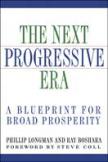Echoes of the Past
Recently repeated cheers that only a few hundred thousand workers lost their jobs may reflect the fact that those who measure, label and publicly analyze the economy are not among the 14 million unemployed Americans as of June. But it is also a sigh of collective relief that, so it seems, the economic crisis that started in 2008 is not a rerun of the Great Depression.
Does this mean that we are not looking at a new New Deal recovery program ushering broadly distributed government-supported social insurance? That is precisely what Phillip Longman and Ray Boshara argue in their new book, and it is hard not to take them seriously once they roll out the precedent of the panics of 1893 and 1907 and their origins and aftermath.
The 1893 debacle, which led to double-digit unemployment for about five years, stemmed from a loss of confidence in certain peculiar bonds backed by mortgages on about half the nation’s 4.1 million homestead farms at the time. These had been sold to uninformed investors in Europe, who fled to gold once fears about their soundness arose.
History does not repeat itself, Mark Twain once remarked, but it rhymes. In Longman and Boshara’s book, another anticipation of the present is the crash of the Knickerbocker Trust and the domino-effect bank and business failures in 1907. By the end of the first decade of the 20th century, some 1,800 failing companies of the 1890s had merged into 93 surviving giant corporations.
Does any of this sound familiar? Once that realization sinks in, the reader will take a second, hard look at the America of bicycles, handlebar mustaches and barbershop quartets popularized by various Disney films and amusement parks as a golden bygone era.
That sepia-toned time, from about 1890 to 1920, was also called the Progressive Era. Back then the competing presidential candidates William Howard Taft, Theodore Roosevelt and Woodrow Wilson eagerly vied for the label “progressive”; it was only later that it became the false flag flown by those afraid to call themselves liberals or leftists in the wake of the cold war political climate.
Progressive reformers like Roosevelt, the authors tell us, created the Federal Reserve System to stave off depression and the Food and Drug Administration to protect the public from fraud, like the original snake oil, sold as a cure-all for aches and pains. (If you want to know what the F.D.A. found in that snake oil, you’ll find out here.)
The authors argue that the progressives’ core value was thrift, in a sense broader than merely saving money. Drawing on its etymological source, “to thrive,” the progressives thought of “thrift of health” and also thrift in terms of time, which the authors argue is the source of the American preoccupation with efficiency.
Nothing illustrates the spirit of the savings education, the interest rate cap that held firm until the early 1980s and the thrifts, credit unions and immigrant banks promoted by the progressive movement better than the records of a Trimmers Club the authors located in Iowa. The group offered a penny a day to any boy who refrained from tobacco, liquor, gambling and swearing. After accumulating their first dollar, the boys were required to deposit 50 cents in a savings account.
Yet our world would not have seemed too strange to them. As in recent years, the nation in their time saw the emergence of a Protestant conservative movement based on a series of tracts called “The Fundamentals.” A kind of globalization began as international trade claimed an increasing share of national income—or loss.
The era had two notable blemishes. Faced with a yearly average of 400 lynchings, many progressives went from ardent advocates of civil rights to strict segregationists, reasoning that the best way to avoid the murderous fruit of Southern bigotry was to force a separation of whites and blacks in the public square. That conclusion led to the fateful Supreme Court decision in Plessy v. Ferguson, in 1896, which sanctioned segregation. Similarly, the era ended with the notorious immigration raids of 1919 to 1921 launched by Alexander Palmer, President Wilson’s attorney general, which targeted foreign leftists as well as Mexicans who were fleeing civil war.
To Longman and Boshara, who acknowledge both horrors, what is lasting in the progressive legacy are the solutions that attempted broad change rather than piecemeal policy tinkering and their institution building, which formed the base for the eventual New Deal.
Last, the progressives embraced a social and economic model that was not purely rational and that, without curtailing America’s pluralism, sought to improve human behavior through a scientifically based “soft paternalism.”
Given the distinctly homiletic quality of President Obama’s major pronouncements, I am tempted to believe that the authors may well have a crystal ball for predicting the nation’s evolution once prosperity returns.
This article also appeared in print, under the headline “Echoes of the Past,” in the September 28, 2009, issue.








